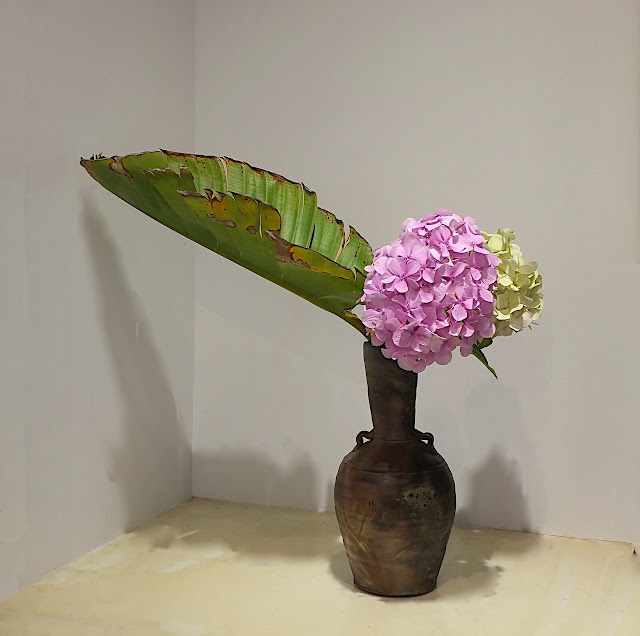This week marked the return to Ikebana activities for 2025.
My Geelong students returned to class last Thursday. Jo's exercise was to make an ikebana using direct fixing. This means not using any mechanics to hold the materials in the desired position. It is particularly difficult when the branch is heavy and is prone to rotate or lean at a not-desired angle.
In this particular instance, Jo had brought two branches of fig with fruit attached. The two shorter branches on the left side are actually a single forking branch. It was heavier on one side and kept rotating until she learnt a new technique of placement that stabilised the branch. The second branch has been passed through the fork in the branch on the left side.
Anne's exercise was Variation No. 3, to be set in a suiban. This variation requires the shin and soe stems to be placed on either side of the hikae and all the materials to be set in the middle of the vessel.
Anne used mauve Zinnias in the centre of the ikebana. Her branch material was not identified.
Because it was the first class for the year I set the senior students the same Variation No. 3 task, as a practise exercise. However, after that exercise, they were then required to make a freestyle arrangement in the same vessel using only the material from the first exercise.
For step two, her freestyle ikebana, Ellie took an abstract approach and disassembled the materials. She placed the flowers and leaves on one side of a length of the Roseberry stem and on the other side, scattered some of the berries, which had not yet turned red.
Unfortunately, I did not photograph all of the ikebana the students made in step one of the exercise. Below are the freestyle ikebana arrangement by the other students.
* * * * *
In the garden the Hydrangeas have survived the few extremely hot days. However, they produced few flowers this year. I think this is because I pruned them rather hard this last winter.
When I arranged the Hydrangea I added the only other one available, slightly smaller and pale green. To balance the mass of the flowers I added a leaf from the Strelitzia nicolai.
The Bizen-style vase is by the Australian ceramicist Ian Jones.
On Monday last week the first meeting for 2025 of Ikebana International Melbourne was held. Click on the link to the new
II Melbourne website.
Greetings from Christopher
16th February 2025


.jpeg)






No comments:
Post a Comment